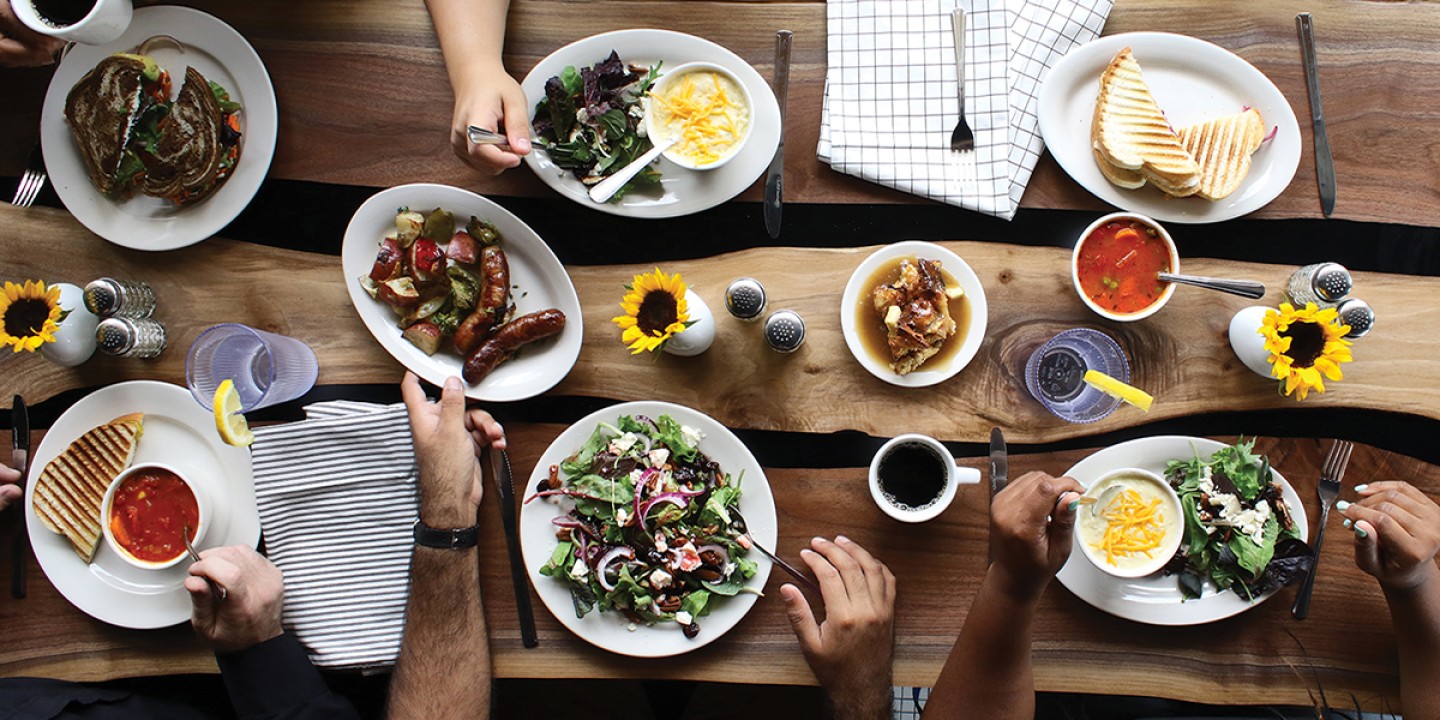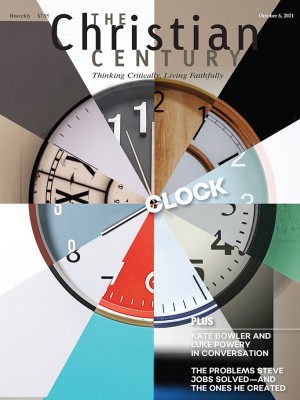How a Serbian Orthodox congregation in Kansas City offers hospitality beyond the liturgy
At Thelma’s Kitchen, every table is a holy table and every guest a living icon.

In the 1930s, a remarkable woman took the name of the ancient ascetic Mary of Egypt, who had turned from prostitution to the life of a desert hermit. On the rue de Lourmel in Paris, Mother Maria set up a house meant to be a center of service to those in need around her. That house—and others that she helped found—became centers of resistance to the Nazis during World War II, while Mother Maria and her companions smuggled Jewish refugees out of the city. Eventually, Mother Maria was arrested by the Gestapo and died in a gas chamber.
It might come as a surprise that one of the legacies of Mother Maria’s work is found in Kansas City, Missouri. A Serbian Orthodox priest was inspired by her example and set up a parish there, dedicated to practicing hospitality in the style of Mother Maria.
Read our latest issue or browse back issues.
David Altschul was a financial services salesman when he felt called to become an Orthodox priest. He became Father Alexii and with his wife, Thelma, found an empty four-story commercial building on Troost Avenue, the historic dividing line between the city’s Black and White communities. They transformed the building to host a plethora of services: a pay-as-you-can restaurant, social and mental health services, a foster grandparents program, a leadership development program, and many other neighborhood-oriented services.
For Mother Maria, the work of making meals, housing homeless people, and creating a sense of welcome and belonging was closely connected to the liturgy, which was celebrated daily in a small chapel in the house. She called the service “liturgy after liturgy” and connected the bread and soup served at the ordinary table in the house with the bread and wine of the Eucharist. That further liturgy involved scavenging food at the market, preparing meals for all who came to the house, listening to the troubled, and getting them medical attention and a place to sleep. She called those who joined her at that table “living icons,” and she insisted that loving our neighbors is the central work of our faith.
Father Alexii caught this vision and saw how it could be readily applied in his Kansas City neighborhood. Eventually he passed it on to a priest named Justin Mathews, who took over for Father Alexii when he retired.
The services offered at the Troost Avenue building are manifold. Under an umbrella called Reconciliation Services, volunteers there offer over 90,000 hours of service annually. Each year they help clients secure almost 2,000 IDs and birth certificates, assist close to 500 people with medical and dental supplies and services, and offer rent and utilities assistance to at least 800 clients. Social and mental health services are received by 3,000 people.
But the heart of the work is found at Thelma’s Kitchen, where people gather for a meal and conversation. As Mother Maria imagined, this is an extension of the Eucharist. Thelma’s Kitchen serves more than 25,000 meals a year, but it is more than a restaurant. Its tables draw people together; it is a doorway for people to the rest of what Reconciliation Services has to offer. At Thelma’s, each table is a place for guests to gather and, over food, drink, and sharing, to become friends of God and of each other.
One way that Father Justin understands Reconciliation Services’ relationship to the church is as “para-sacramental.” John Chrysostom wrote of the continuing of the eucharistic liturgy, begun on the altar in church, to the heart of our neighbor. This connecting of liturgy and life, what Mother Maria also called “the liturgy outside the church,” is central to the relationship between the two great commandments. Mother Maria insisted that these are not two separate commandments: faithful practice of each teaches us how to practice the other.
In her writings, Mother Maria constantly argued against critics who thought her houses of hospitality were a choice of social activism over the “one thing necessary”—the divine office, eucharistic liturgy, and prayer. She tracked the integrity of the love of God and neighbor through the Desert Mothers and Fathers, noting as well that Eastern saints such as Basil the Great, Nilus of Sora, Joseph of Volokolamsk, Juliana the Merciful, and Sergius of Radonezh saw love of God and of neighbor as essential to each other.
Throughout the ancient world, through all kinds of social changes, there were diaconal centers—centers of service—that stretched church into world, liturgy into life. Basil the Great set one up, known as the Basiliad, in Caesarea in Asia Minor—now Kayseri, in Turkey’s Cappadocia region. Diaconal centers contained hostels for the homeless, hospitals for the sick, hospices for the dying, soup kitchens, clothing pantries, and even schools. They were also locations of liturgical gathering on Sundays and feasts, places where the Eucharist was celebrated.
Mother Maria did not use the term para-sacramental. It is a contemporary term, and one open to confusion and misunderstanding, given rigorous views that there are but two or seven sacraments, depending on who is doing the counting. At the same time, we must remember how fluid this understanding of sacrament has been in Christian tradition, both East and West. One medieval theologian identified 30 sacraments. For Mother Maria, the issue was not so much how many sacraments were included, but what tangible things people were doing to perform diakonia—loving service to one’s neighbor. When she stressed the relationship between liturgy and life, between the bread and cup and the table set to feed the hungry, she echoed what we read of Jesus’ ministry in the Gospels. She argued extensively in her writings that love of neighbor must include “concrete, practical acts.” We cannot fulfill the second commandment in the abstract.
This is how Father Alexii and Father Justin have proceeded. Through the work of Reconciliation Services, they seek to see their neighbors as living icons, to extend the love of God through concrete acts, and so to participate in the diakonia to which they are called by Christ.
When a man named Terrance suffered a relapse after months of sobriety, he found connection at Reconciliation Services that allowed him to start over. In time, he earned a master’s in social work and now offers counseling to those struggling for recovery as he did. When Cassandra was released from prison, she found a women’s support group at Reconciliation Services. She found a way to choose a path of healing and hope. When Nora found support for her posttraumatic stress disorder, when Paul was able to stabilize his health, when Pamela started cooking at Thelma’s Kitchen—each of them served as a living icon to the entire community.
This kind of robust diakonia is not easy to keep alive in any parish, and in the Orthodox community of Kansas City, it is no easier. In almost any church setting, there are always forces that want to extend and forces that want to withdraw. Generosity competes with self-preservation. But Mother Maria showed the elasticity of church, the ways in which the conventional model of a parish could extend outward toward the neighbor, in whose face one always sees Christ.
Perhaps this is a lesson for the local church in the 21st century. When congregations dwindle in membership and budgets shrink, churches can retreat into survival mode. Resources are reserved for keeping the roof repaired and the heat on. But the example of Reconciliation Services on Troost Avenue offers a path both innovative and ancient.
The liturgy after the liturgy continues all week. Just as in Mother Maria’s houses and now on Troost Avenue, every table is a holy table. The conversation and tears and laughter during a meal are truly a liturgy, the Eucharist extended into the lives of all the people of God.
A version of this article appears in the print edition under the title “Holy tables, living icons.”






